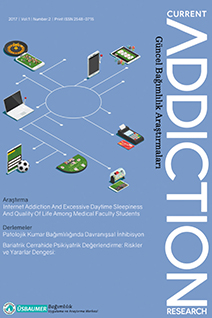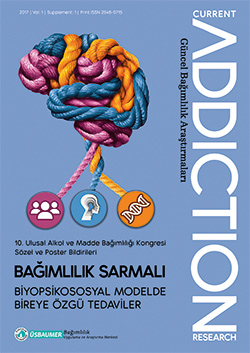ARTICLES
Original Article
Comparison of the Attachment Styles of Cigarette Smokers and Nonsmokers
Beyza Yaz,Hüseyin Ünübol,Gökben Hızlı Sayar
2019, 3(1), s:11-15
Aim: This study aimed to compare the attachment styles of smokers and nonsmokers.
Methods: 2800 individuals who participated in the study were given sociodemographic form and “Experiences in Close Relationships Scale”.
Results: Younger ages, male sex, low educational levels found to be related to smoking status. However smoking status or the number of daily smoked cigarettes not found to be related to attachment style.
Conclusion: According to the results of the study, attachment styles were not significantly different according to smoking status. The results of this study suggest that the other comorbid psychopathologies might be a more important risk factor than attachment style in smoking.
Original Article
Haydar Hoşgör,Derya Gündüz Hoşgör
2019, 3(1), s:16-24
Objective: The aim of this study is to examine the effect of the fear of missing out on the nomophobia, and to determine whether differences between these variables and demographic features.
Method: In accordance with this purpose, the students who were studying at the Department of Health Management in 2017-2018 autumn semester at universities in Istanbul were included in this study and data of 273 respondent were evaluated. Personal information form and FoMO and Nomophobia scales were used for data collection. Descriptive statistics, t-test, correlation and regression analyses were used in the data analysis.
Results: According to the analysis outcomes, the levels of nomophobia and FoMO of the students are above average. The results of the study demonstrate that there is a significant relation at a moderate level and positive direct relationship between nomophobia and fear of missing out, as well as the fear of missing out explains 30% of nomophobia. Also, the results show that there are statistically significant differences between students’ levels of nomophobia and fear of missing out, and their demographic features. Moreover, these differences are stem from students who control his smartphone at least 33 times a day, carry a continuous charger, control his smartphone as soon as waking up, connect to the social media via the smartphone.
Conclusion: It has been concluded that for future healthcare manager candidates, the fear of missing out on social networks is a predictor of nomophobia, also known as the fear of being deprived of the smartphone.



 2. Sayı
2. Sayı
 1. Sayı
1. Sayı
 Ek Sayı
Ek Sayı







